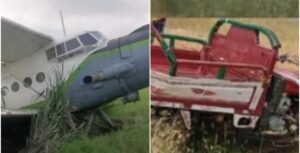

What would happen if there was a full-scale nuclear war between Russia and the United States?
Based on non-classified data, the aftermath might go something like this.
When one side launches nuclear missiles, the other side detects them and fires back before impact.
U.S.
submarine-launched ballistic missiles from west of Norway start striking Russia after about 10 minutes.
And Russian ones from north of Canada start hitting the U.S.
a few minutes later.
The very first strikes are high-altitude EMP attacks, frying electronics and power grids by creating an electromagnetic pulse of tens of thousands of volts per meter.
The next strikes target command and control, as well as nuclear launch facilities.
Land-based intercontinental ballistic missiles take about half an hour to arrive.
Major cities are targeted, both because they contain military facilities and to stymie the enemy’s post-war recovery.
Some cruise missiles take hours to reach their target.
Each impact creates a fireball about as hot as the core of the sun, followed by a radioactive mushroom cloud.
These intense explosions vaporize people nearby and cause fires and blindness further away.
The fireball expansion then causes a blast wave that damages buildings, crushing nearby ones.
The United Kingdom and France have nuclear capabilities and are obliged by NATO’s Article 5 to defend the U.S.
So Russia hits them, too.
Firestorms engulf many cities, where storm-level winds fan the flames, igniting anything that can burn, melting glass and some metals, and turning asphalt into flammable hot liquid.
But the explosions, the electromagnetic pulse, and the radioactivity aren’t the worst part.
Nuclear winter is, caused by the black carbon smoke from the nuclear firestorms.
The Hiroshima atomic bomb caused such a firestorm, but today’s hydrogen bombs are much more powerful.
A large city like Moscow, with almost 50 times more people, can create much more smoke.
And a firestorm sends plumes of black smoke up into the stratosphere, far above any rain clouds that would otherwise wash out the smoke.
This black smoke gets heated by sunlight, lofting it like a hot air balloon for up to a decade.
High-altitude jet streams are so fast that it takes only a few days for the smoke to spread across much of the northern hemisphere.
In the meantime, Earth gets freezing cold, even during the summer, with farmland in Kansas cooling by about 20 degrees centigrade, or 40 degrees Fahrenheit, and other regions cooling almost twice as much.
A recent scientific paper estimates that over 5 billion people could starve to death.
Including around 99% of those in the United States, Europe, Russia, and China.
We obviously don’t know how many people will survive a nuclear war.
But if it’s even remotely as bad as scientists think, then it has no winners, merely losers.
It’s easy to feel powerless, but the good news is that there is something you can do to help.
Please share this video, because the more people know about nuclear war, the less likely it is that we’ll start one.





